Comparison and Evaluation of Large-Scale and On-Site Recycling Systems for Food Waste via Life Cycle Cost Analysis
Abstract
:1. Introduction
2. Material and Methods
2.1. Goal and Scope
2.2. Data Quality and Collection
2.3. Assumptions and Estimates for the LCC Analysis
2.4. Scenario Construction and Description
2.4.1. Large-Scale Treatment System
2.4.2. On-Site Recycling Treatment System
2.5. Analysis Items for Each Stage
2.5.1. Separation/Discharge Stage
2.5.2. Collection/Transportation Stage
2.5.3. Treatment Stage
Large-Scale Treatment System Facility (Aerobic Composting)
On-Site Recycling System Facility (Small-Scale Composting)
Municipal Waste Treatment Fee
2.5.4. Final Disposal
Food Wastewater Treatment Cost
Environmental Improvement Benefits Due to Reduction in Food Wastewater Generation
Benefits Due to Greenhouse Gas Reduction
Byproduct Utilization
2.6. Estimation of Willingness to Pay (WTP)
3. Results and Discussion
3.1. Cost-Benefit Analysis for Local Governments
3.1.1. Analysis Results of the Large-Scale Treatment System for Local Governments
3.1.2. Analysis Results of On-Site Food Waste Recycling System for Local Governments
3.2. Cost-Benefit Analysis for Residents
3.2.1. Analysis Results of Large-Scale Treatment System for Residents
3.2.2. Analysis Results of On-Site Food Waste Recycling System for Residents
4. Conclusions
Acknowledgments
Author Contributions
Conflicts of Interest
References
- Cho, C.-H.; Lee, B.; Lee, Y.-W. The Treatment of Source Separated Food Waste by Mesophilic Anaerobic Digestion System with Leachate Recirculation. J. Korea Org. Resour. Recycl. Assoc. 2016, 24, 31–40. [Google Scholar] [CrossRef]
- Lee, D.J.; Yoon, Y.M.; Choi, I.W.; Bae, J.S.; Seo, D.C. Effect of seasonal variations of organic loading rate and acid phase on methane yield of food waste leachate in South Korea. Appl. Biol. Chem. 2017, 60, 87–93. [Google Scholar] [CrossRef]
- Hong, Y.-P.; Kim, H.-S.; Kim, U.-Y.; Shin, H.-G. Study on the Public Food Waste Recycling Facility Operation (I)-Focusing on the Current State of Operation and the Problems. J. Korea Org. Resour. Recycl. Assoc. 2016, 24, 41–49. [Google Scholar] [CrossRef]
- Kim, H.; Pak, D. Effect of Temperature on Torrefaction of Food Waste using Heat Carrier. In Environmental Science and Sustainable Development, Proceedings of the International Conference on Environmental Science and Sustainable Development (ICESSD 2015), Bangkok, Thailand, 25–26 October 2015; World Scientific Publishing Co.: Singapore, 2016; pp. 268–276. [Google Scholar]
- Lee, S.-H.; Choi, K.-I.; Osako, M.; Dong, J.-I. Evaluation of environmental burdens caused by changes of food waste management systems in Seoul, Korea. Sci. Total. Environ. 2007, 387, 42–53. [Google Scholar] [CrossRef] [PubMed]
- Sung, T.; Kim, S.; Kim, K.C. Thermoeconomic analysis of a biogas-fueled micro-gas turbine with a bottoming organic Rankine cycle for a sewage sludge and food waste treatment plant in the Republic of Korea. Appl. Therm. Eng. 2017, 127, 963–974. [Google Scholar] [CrossRef]
- Nguyen, D.D.; Yeop, J.S.; Choi, J.; Kim, S.; Chang, S.W.; Jeon, B.-H.; Guo, W.; Ngo, H.H. A new approach for concurrently improving performance of South Korean food waste valorization and renewable energy recovery via dry anaerobic digestion under mesophilic and thermophilic conditions. Waste Manag. 2017, 66, 161–168. [Google Scholar] [CrossRef] [PubMed]
- Salemdeeb, R.; zu Ermgassen, E.K.; Kim, M.H.; Balmford, A.; Al-Tabbaa, A. Environmental and health impacts of using food waste as animal feed: a comparative analysis of food waste management options. J. Clean. Prod. 2017, 140, 871–880. [Google Scholar] [CrossRef] [PubMed]
- Song, H.; Kim, D. Study on Feasibility of Integrated Two-Phase Anaerobic Digestion Using Foodwaste Water by Reviewing of Operating Efficiency. J. Korea Org. Resour. Recycl. Assoc. 2016, 24, 59–66. [Google Scholar] [CrossRef]
- Hong, Y.-P.; Kim, U.-Y.; Shin, H.-G. Study on the Public Food Waste Recycling Facility Operation (II)-Focusing on Improvement Plan. J. Korea Org. Resour. Recycl. Assoc. 2016, 24, 51–57. [Google Scholar] [CrossRef]
- Lim, K.-T.; Lee, J.-C.; Cheong, J.-H.; Jung, W.-J.; Kim, T.-H. Meat quality of mallard by feeding of MS-fermented food waste. Korean J. Environ Agric. 2000, 19, 332–338. [Google Scholar]
- Han, S.-K.; Shin, H.-S. Biohydrogen production by anaerobic fermentation of food waste. Int. J. Hydrogen Energy 2004, 29, 569–577. [Google Scholar] [CrossRef]
- Kim, J.K.; Oh, B.R.; Chun, Y.N.; Kim, S.W. Effects of temperature and hydraulic retention time on anaerobic digestion of food waste. J. Biosci. Bioeng. 2006, 102, 328–332. [Google Scholar] [CrossRef] [PubMed]
- Kim, M.-H.; Song, Y.-E.; Song, H.-B.; Kim, J.-W.; Hwang, S.-J. Evaluation of food waste disposal options by LCC analysis from the perspective of global warming: Jungnang case, South Korea. Waste Manag. 2011, 31, 2112–2120. [Google Scholar] [CrossRef] [PubMed]
- Cho, H.-N. Practical approaches to the application of life-cycle civil engineering for infrastructure in Korea. Life Cycle Civ. Eng. 2008, 1, 21–34. [Google Scholar]
- Kang, C.-H.; Choi, T.-H.; Kim, Y.-S. A Case Study on the Economic Analysis of Type PSCI Bridge Using LCC Technique. J. Korean Soc. Civ. Eng. 2005, 25, 91–99. [Google Scholar]
- Lim, S.R.; Park, J.M. Environmental and economic analysis of a water network system using LCA and LCC. AIChE J. 2007, 53, 3253–3262. [Google Scholar] [CrossRef]
- Kim, M.-H.; Kim, J.-W. Comparison through a LCA evaluation analysis of food waste disposal options from the perspective of global warming and resource recovery. Sci. Total. Environ. 2010, 408, 3998–4006. [Google Scholar] [CrossRef] [PubMed]
- Kim, M.H.; Song, H.B.; Song, Y.; Jeong, I.T.; Kim, J.W. Evaluation of food waste disposal options in terms of global warming and energy recovery: Korea. Int. J. Energy Environ. Eng. 2013, 4, 1. [Google Scholar] [CrossRef]
- Ministry of Environment. The National Solid Waste Generation and Management Status in South Korea; Ministry of Environment: Sejong, Korea, 2015.
- Gangnamgu Office. Stable Disposal System of Food Waste; Gangnamgu office: Seoul, Korea, 2013.
- Yoo, S.S.; Oh, J.; Lee, K.H.; Ko, K.H. Evaluation and comparison of CO2 emissions of food-waste disposal systems through life cycle assessment. Desalination Water Treat. 2017, in press. [Google Scholar]

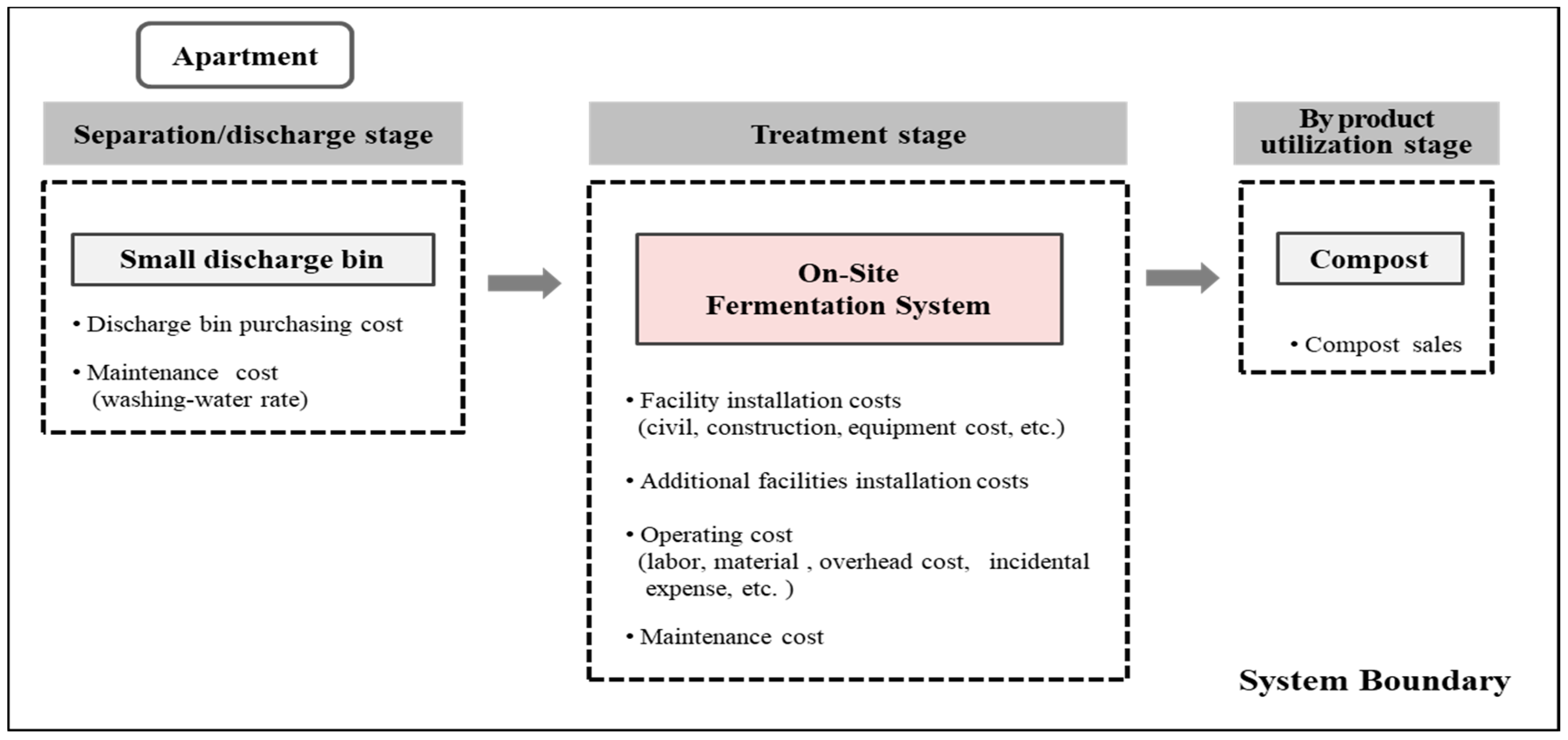
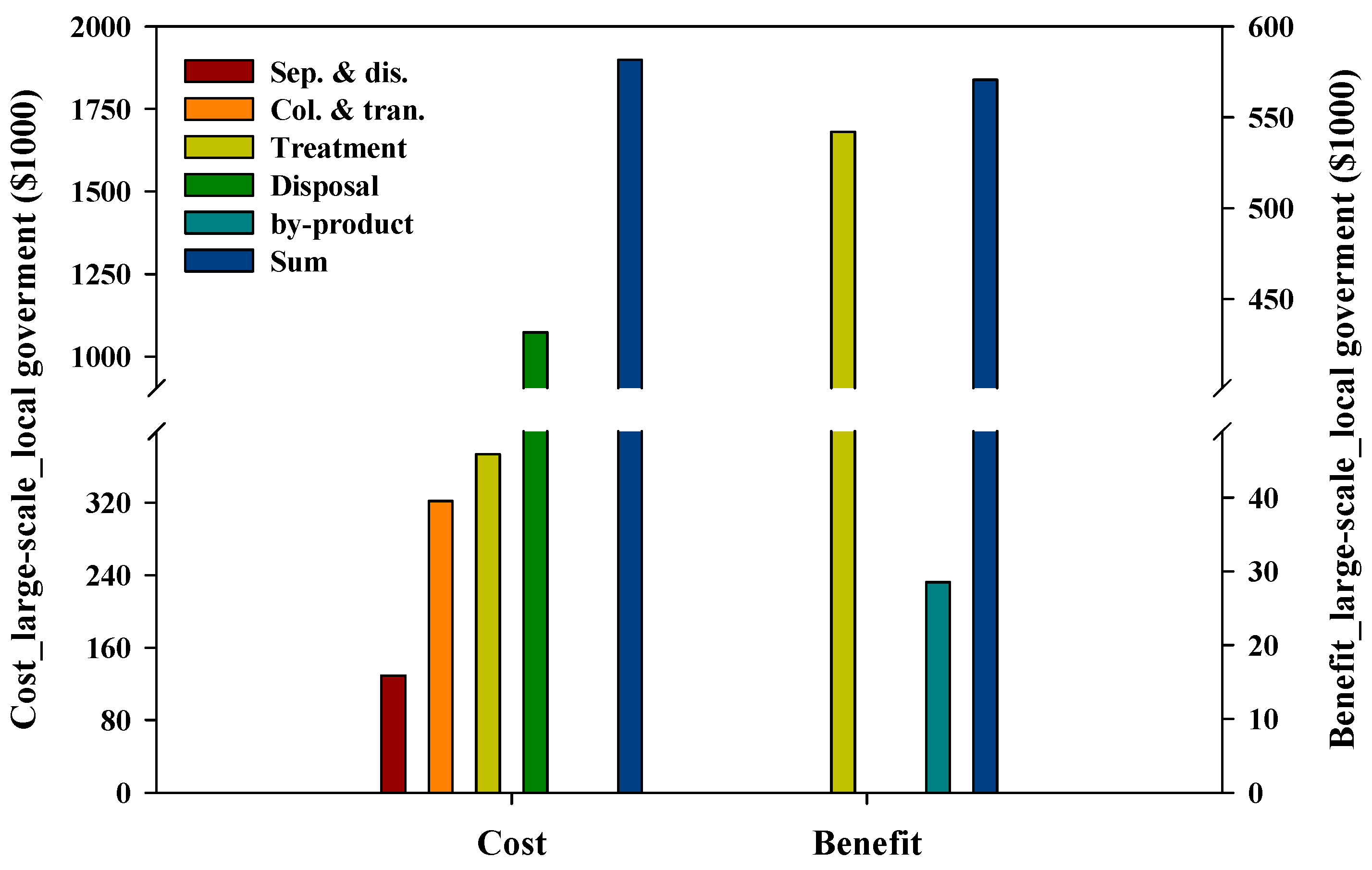
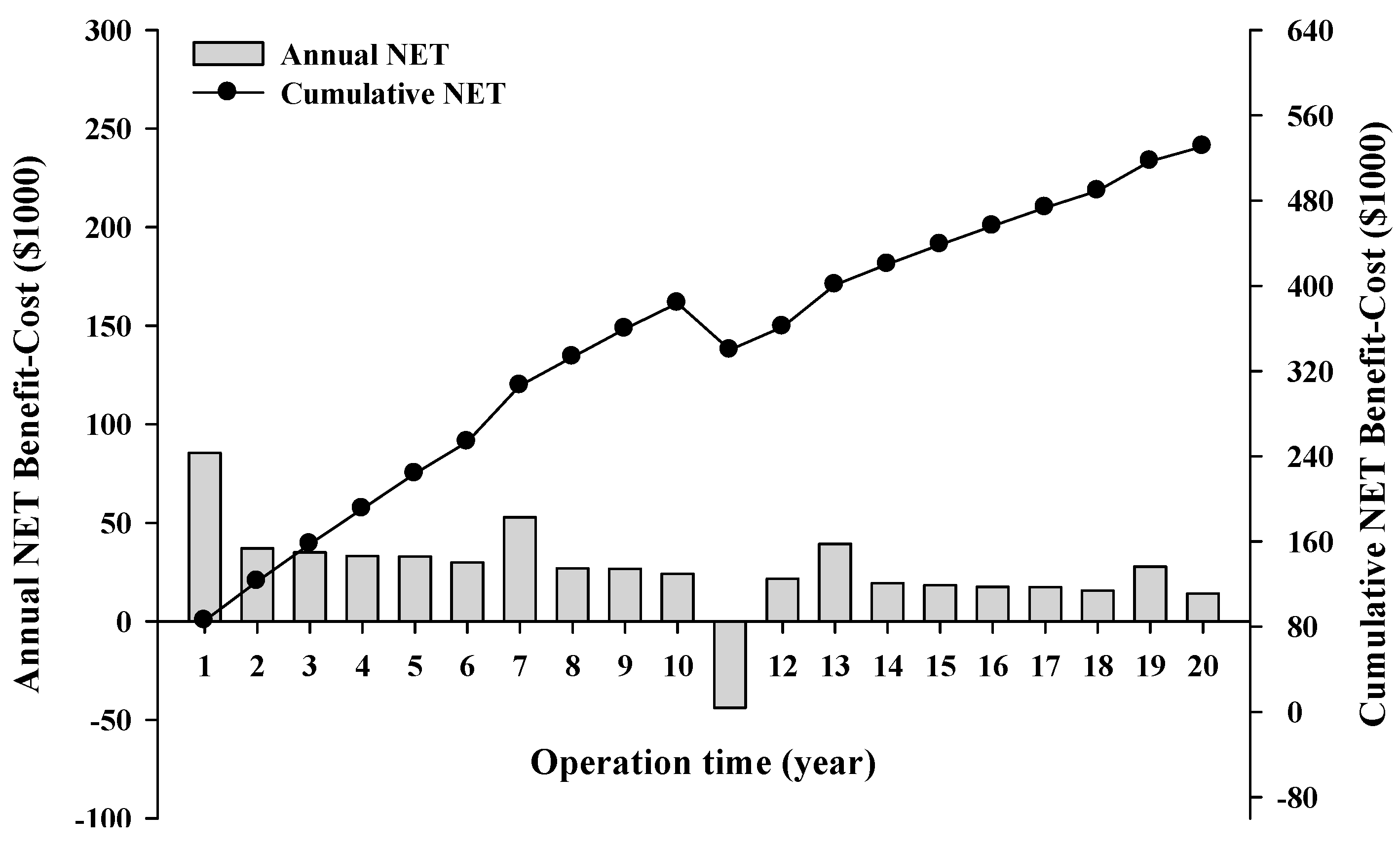
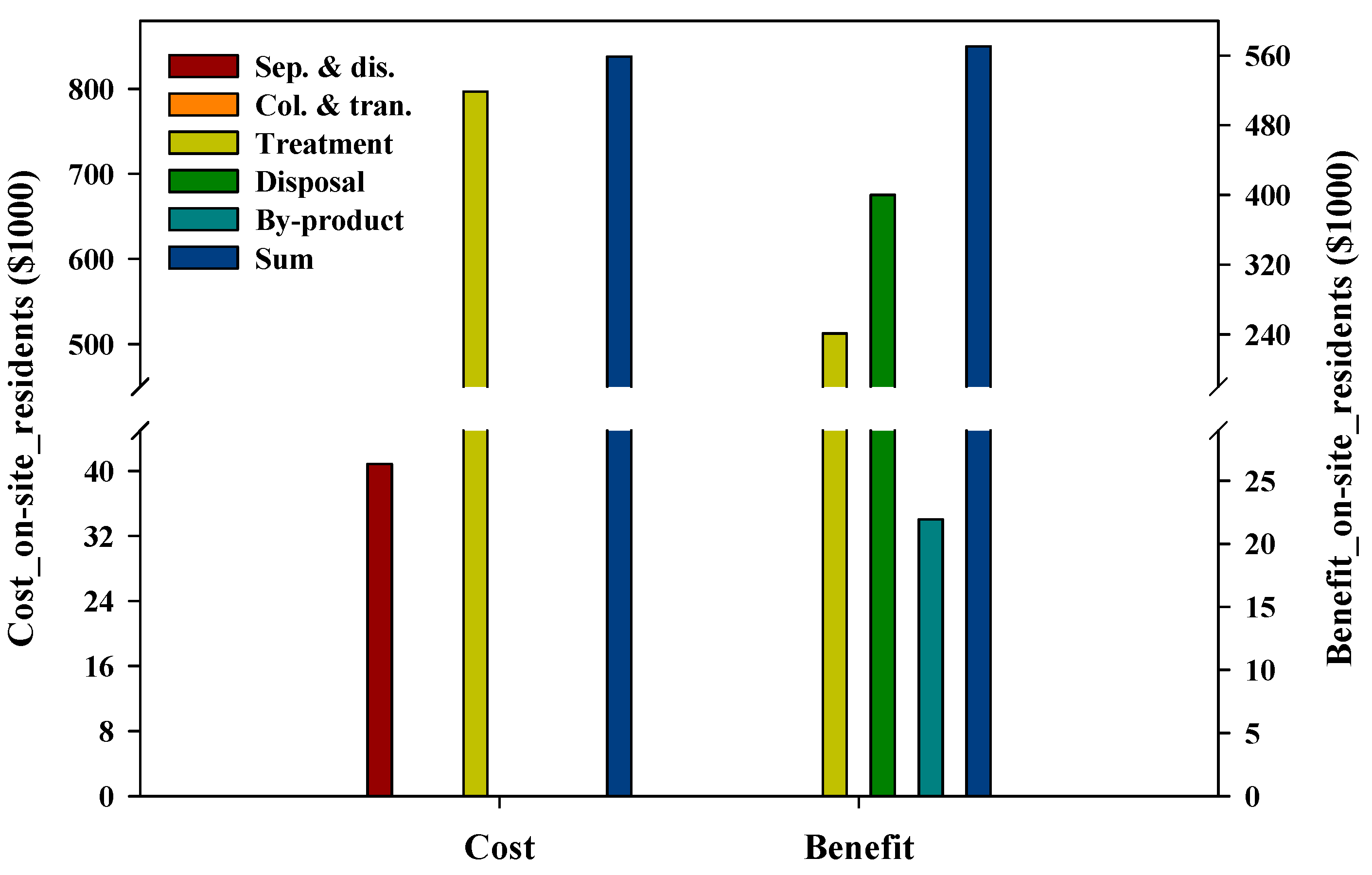
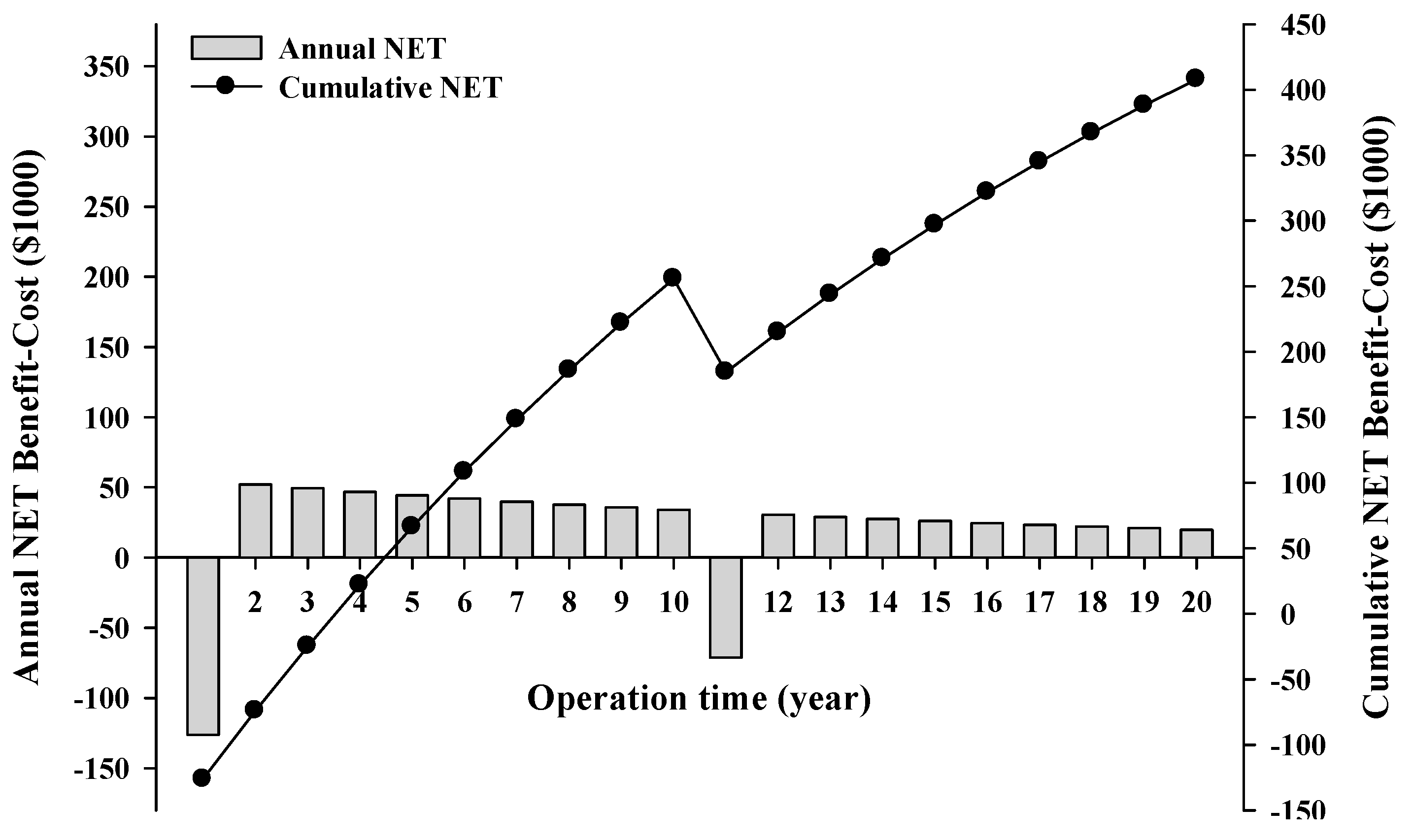
| Treatment System | |||||
|---|---|---|---|---|---|
| Stage | Large-Scale | On-Site | |||
| Costs | Benefits | Costs | Benefits | ||
| Local government | Separation/Discharge | RFID meter installation, telecommunication information management and maintenance | - | - | - |
| Collection/transportation | Collection vehicle purchase and operation | - | - | - | |
| Treatment | Facility installation, maintenance, and management; waste treatment commission | - | Device and auxiliary facility installation and maintenance | - | |
| Byproduct | - | Compost sales | - | - | |
| Final disposal | Contamination and food wastewater treatment | - | - | - | |
| Residents | Separation/discharge | Dedicated small containers and cleaning water | - | Dedicated small containers and cleaning water | - |
| Collection/transportation | - | - | - | - | |
| Treatment | Waste treatment commission | - | Device and auxiliary facility installation and maintenance | - | |
| Byproduct | - | - | - | Compost utilization | |
| Final disposal | - | - | - | Environmental improvement benefit | |
| Category | Value | |
|---|---|---|
| Survey | Target | A woman aged 20 or over who lives in an apartment. |
| Area | Ansan-Si (boner village) Seoul (Gangnam, seocho, songpa) Goyang-Si (Ilsan) Sungnam-Si (Bundang) | |
| Method | Face to face interview | |
| Period | 12–25 January 2017 (14 days) | |
| Sample | Number | 400 people (valid sample) |
| Method | Quota sampling |
| Type | Stage | Item | Cost ($) | Benefit ($) |
|---|---|---|---|---|
| On-site recycling system | Separation/discharge | - | - | - |
| Collection/transportation | - | - | - | |
| Treatment | Production and installation of Fermentation-extinction equipment | 280,111 | - | |
| Auxiliary facilities production | 4417 | - | ||
| Maintenance | 13,766 | - | ||
| Operation management | 498,436 | - | ||
| Final disposal | - | - | - | |
| Byproduct utilization | - | - | - |
| Type | Stage | Item | Cost ($) | Benefit ($) |
|---|---|---|---|---|
| Large-scale treatment system | Separation/discharge | Small container purchase | 40,193 | - |
| Small container cleaning | 668 | - | ||
| Collection/transportation | - | - | - | |
| Treatment | Food waste treatment commission | 542,025 | - | |
| Final disposal | - | - | - | |
| Byproduct utilization | - | - | - |
© 2017 by the authors. Licensee MDPI, Basel, Switzerland. This article is an open access article distributed under the terms and conditions of the Creative Commons Attribution (CC BY) license (http://creativecommons.org/licenses/by/4.0/).
Share and Cite
Lee, K.H.; Oh, J.-i.; Chu, K.H.; Kwon, S.H.; Yoo, S.S. Comparison and Evaluation of Large-Scale and On-Site Recycling Systems for Food Waste via Life Cycle Cost Analysis. Sustainability 2017, 9, 2186. https://doi.org/10.3390/su9122186
Lee KH, Oh J-i, Chu KH, Kwon SH, Yoo SS. Comparison and Evaluation of Large-Scale and On-Site Recycling Systems for Food Waste via Life Cycle Cost Analysis. Sustainability. 2017; 9(12):2186. https://doi.org/10.3390/su9122186
Chicago/Turabian StyleLee, Kyoung Hee, Jeong-ik Oh, Kyoung Hoon Chu, Suk Hyun Kwon, and Sung Soo Yoo. 2017. "Comparison and Evaluation of Large-Scale and On-Site Recycling Systems for Food Waste via Life Cycle Cost Analysis" Sustainability 9, no. 12: 2186. https://doi.org/10.3390/su9122186




